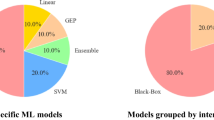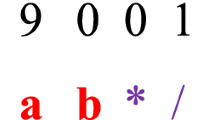New nonlinear solutions were developed to estimate the soil shear strength parameters utilizing linear genetic programming (LGP). The soil cohesion intercept (c) and angle of shearing resistance (ϕ) were formulated in terms of the basic soil physical properties. The best models were selected after developing and controlling several models with different combinations of influencing parameters. Comprehensive experimental database used for developing the models was established upon a series of unconsolidated, undrained, and unsaturated triaxial tests conducted in this study. Further, sensitivity and parametric analyses were carried out. c and ϕ were found to be mostly influenced by the soil unit weight and liquid limit. In order to benchmark the proposed models, a multiple least squares regression (MLSR) analysis was performed. The validity of the models was proved on portions of laboratory results that were not included in the modelling process. The developed models are able to effectively learn the complex relationship between the soil strength parameters and their contributing factors. The LGP models provide a significantly better prediction performance than the regression models.
Similar content being viewed by others
References
Alavi A H and Gandomi A H 2011a Prediction of principal ground-motion parameters using a hybrid method coupling artificial neural networks and simulated annealing; Comput. Struct., doi: 10.1016/j.compstruc. 2011.08.019.
Alavi A H and Gandomi A H 2011b A robust data mining approach for formulation of geotechnical engineering systems; Int. J. Comput. Aided Meth. Eng.-Eng. Computations 28(3) 242–274.
Alavi A H, Gandomi A H, Gandomi M and Sadat Hosseini S S 2009 Prediction of maximum dry density and optimum moisture content of stabilized soil using RBF neural networks; The IES J Part A: Civil. Struct. Eng. 2 98–106.
Alavi A H, Gandomi A H, Sahab M G and Gandomi M 2010 Multi expression programming: A new approach to formulation of soil classification; Eng. Comput. 26(2) 111–118.
Alavi A H, Ameri M, Gandomi A H and Mirzahosseini M R 2011 Formulation of flow number of asphalt mixes using a hybrid computational method; Constr. Build. Mater. 25(3) 1338–1355.
Arora K R 1988 Introductory soil engineering; text book. Nem Chand Jane (Prop), Standard Publishers Distributors, Nai Sarak, Delhi.
ASTM D 6528 Consolidated undrained direct simple shear testing of cohesive soils.
ASTM D2850-87 Standard Test Method for Unconsolidated, Undrained Compressive Strength of Cohesive Soils in Triaxial Compression.
ASTM WK3821 New test method for consolidated drained triaxial compression test for soils.
Aytek A and Alp M 2008 An application of artificial intelligence for rainfall-runoff modeling; J. Earth Syst. Sci. 117(2) 145–155.
Banzhaf W, Nordin P, Keller R and Francone F 1998 Genetic programming – An introduction on the automatic evolution of computer programs and its application; dpunkt/Morgan Kaufmann, Heidelberg/San Francisco.
Barends F B J, Lindenberg J L, De Quelerij L, Verruijt A and Luger H J 1999 Geotechnical Engineering for Transportation Infrastructure: Theory and Practice, Planning and Design, Construction and Maintenance; Balkema Publishers, Netherlands.
Baykasoglu A, Gullub H, Canakcı H and Ozbakır L 2008 Prediction of compressive and tensile strength of limestone via genetic programming; Expert. Syst. Appl. 35(1–2) 111–123.
Bowles J E 1992 Engineering properties of soils and their measurement; McGraw-Hill, New York.
Brameier M and Banzhaf W 2001 A comparison of linear genetic programming and neural networks in medical data mining; IEEE Trans. Evol. Com. 5(1) 17–26.
Brameier M and Banzhaf W 2007 Linear Genetic Programming; Springer Science + Business Media, New York.
Cevik A and Cabalar A F 2009 Modelling damping ratio and shear modulus of sand–mica mixtures using genetic programming; Expert. Syst. Appl. 36(4) 7749–7757.
Conrads M, Dolezal O, Francone F D and Nordin P 2004 Discipulus – fast genetic programming based on AIM learning technology; Register Machine Learning Technologies Inc, Littleton, CO.
Deschaine L M 2000 Using Genetic Programming to Develop a C/C+ + Simulation Model of a Waste Incinerator Science Applications; International Corp, Draft Technical Report.
El-Maksoud M A F 2006 Laboratory determining of soil strength parameters in calcareous soils and their effect on chiseling draft prediction; In: Proceedings of Energy Efficiency and Agricultural Engineering International Conference, Rousse, Bulgaria.
Feldt R and Nordin P 2000 Using Factorial Experiments to Evaluate the Effect of Genetic Programming Parameters; In: Proceedings of EuroGP 2000 LNCS 1802 pp. 271–282.
Francone F D 2001 Discipulus ProTM Software Owner’s Manual; Register Machine Learning Technologies Inc: Littleton, CO.
Francone F D 2004 Discipulus LiteTM Software Owner’s Manual, Littleton, CO, USA, Machine Learning Technologies Inc.
Frank I E and Todeschini R 1994 The data analysis handbook; Elsevier, Amsterdam, The Netherland.
Gandomi A H and Alavi A H 2011 Multi-stage genetic programming: A new strategy to nonlinear system modeling; Inf. Sci. 181(23) 5227–5239.
Gandomi A H, Alavi A H and Sadathosseini S S 2008 A discussion on genetic programming for retrieving missing information in wave records along the west coast of India; Appl. Ocean Res. 30 338–339.
Gandomi A H, Alavi A H and Sahab M G 2010 New formulation for compressive strength of CFRP confined concrete cylinders using linear genetic programming; Mater. Struct. 43(7) 963–983.
Gandomi A H, Alavi A H, Mirzahosseini R and Moqaddas Nezhad F 2011a Nonlinear genetic-based models for prediction of flow number of asphalt mixtures; J. Mater. Civil Eng. ASCE 23(3) 1–18.
Gandomi A H, Alavi A H and Yun G J 2011b Nonlinear modeling of shear strength of sfrcb beams using linear genetic programming; Struct. Eng. Mech. 38(1) 1–25.
Guven A 2009 Linear Genetic Programming for time-series modelling of daily flow rate; J. Earth Syst. Sci. 118(2) 137–146.
Guven A, Gunal M and Cevik A 2006 Prediction of pressure fluctuations on stilling basins; Can. J. Civ. Eng. 33(11) 1379–1388.
Guven A, Aytek A, Yuce M I and Aksoy H 2007 Genetic programming-based empirical model for daily reference evapotranspiration estimation; CLEAN–Soil Air Water J. 36(10–11) 905–912.
Guven A, Azamathullab H M and Zakaria N A 2009 Linear Genetic Programming for prediction of circular pile scour; Ocean Eng. 36(12–13) 985–991.
Heshmati A A R, Alavi A H, Keramati M and Gandomi A H 2009 A radial basis function Neural Network Approach for compressive strength prediction of stabilized soil; Geotech. Spec. Publ. ASCE 191 147–153.
Javadi A A and Rezania M 2009 Applications of artificial intelligence and data mining techniques in soil modelling; Geomech. Eng. 1(1) 53–74.
Kasabov N K 1998 Foundations of neural networks fuzzy systems and knowledge engineering; Cambridge, MIT Press.
Kayadelen C, Günaydın O, Fener M, Demir A and Özvan A 2009 A modeling of the angle of shearing resistance of soils using soft computing systems; Expert. Syst. Appl. 36 11,814–11,826.
Korayem A Y, Ismail K M and Sehari S Q 1996 Prediction of soil shear strength and penetration resistance using some soil properties; Mis. J. Agr. Res. 13(4) 119–140.
Koza J 1992 Genetic programming, on the programming of computers by means of natural selection; Cambridge (MA), MIT Press.
Kraslawski A, Pedrycz W and Nyström L 1999 Fuzzy Neural Network as instance generator for case-based reasoning system: An example of selection of heat exchange equipment in mixing; Neu. Comput. Appl. 8(2) 106–113.
Maravall A and Gomez V 2004 Eviews Software; Version 5. Quantitative Micro Software, LLC, Irvine CA.
Mesbahi E 2000 Application of artificial neural networks in modelling and control of diesel engines; PhD Thesis, University of Newcastle, UK.
Mollahasani A, Alavi A H, Gandomi A H and Rashed A 2011 Nonlinear neural-based modeling of soil cohesion intercept; KSCE J. Civil. Eng. 15(5) 831–840.
Mousavi S M, Alavi A H, Gandomi A H and Mollahasani A 2011 Formulation of soil angle of shearing resistance using a hybrid GP and OLS Mehod; Eng. Comput. in press. doi: 10.1007/s00366-011-0242-x
Murthy S 2008 Geotechnical Engineering: Principles and Practices of Soil Mechanics; 2nd edn, Taylor & Francis, CRC Press, UK.
Oltean M and Grosan C 2003 A comparison of several linear genetic programming techniques; Complex Syst. 14(4) 1–29.
Panwar J S and Seimens J C 1972 Shear strength and energy of soil failure related to density and moisture; T. ASAE 15 423–427.
Poli R, Langdon W B, McPhee N F and Koza J R 2007 Genetic programming: An introductory tutorial and a survey of techniques and applications; Technical report [CES-475], University of Essex, UK.
Ryan T P 1997 Modern Regression Methods; Wiley, New York.
Shahin M A, Jaksa M B and Maier H R 2009 Recent advances and future challenges for artificial neural systems in geotechnical engineering applications; Adv. Artif. Neur. Syst., Article ID 308239.
Shahin M A, Maier H R and Jaksa M B 2001 Artificial neural network applications in geotechnical engineering; Aus. Geomech. 36(1) 49–62.
Smith G N 1986 Probability and statistics in civil engineering; Collins, London.
Swingler K 1996 Applying neural networks: A practical guide; Academic Press, New York.
Terzaghi K, Peck R B and Mesri G 1996 Soil mechanics in engineering practice, 3rd edn, Wiley & Sons, Inc, New York.
Author information
Authors and Affiliations
Corresponding author
Rights and permissions
About this article
Cite this article
MOUSAVI, S.M., ALAVI, A.H., GANDOMI, A.H. et al. Nonlinear genetic-based simulation of soil shear strength parameters. J Earth Syst Sci 120, 1001–1022 (2011). https://doi.org/10.1007/s12040-011-0119-9
Received:
Revised:
Accepted:
Published:
Issue Date:
DOI: https://doi.org/10.1007/s12040-011-0119-9




